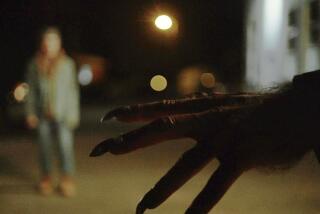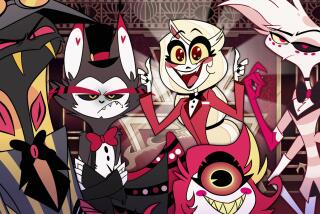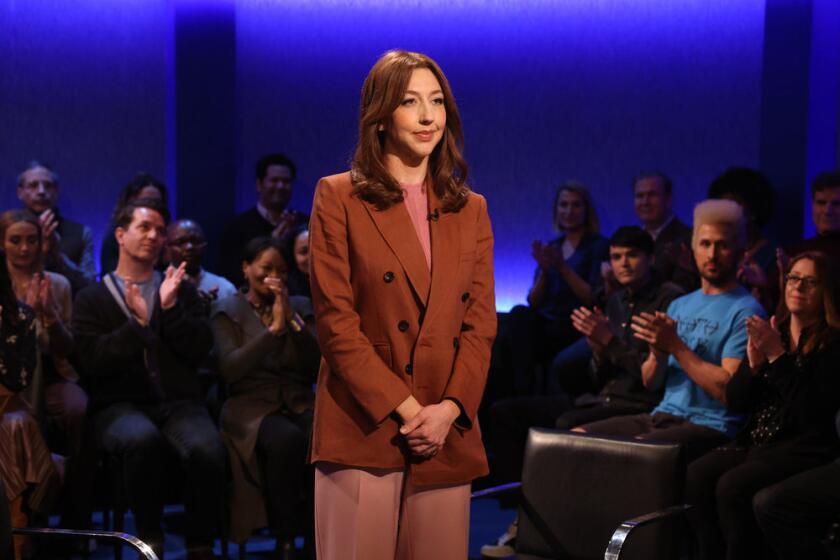‘Creepshow’ is the cure for ‘elevated horror’ fatigue
Several people in the cast and crew of “Creepshow,” Shudder’s series adaptation of the 1982 Stephen King-written horror movie, claim to have been personally affected by the film. But writer Joe Hill is in rare company, having actually contributed to both.
“I was a child actor in the first film,” said Hill, the son of the prolific horror author and an accomplished genre writer in his own right. “I played a little boy named Billy, who uses a voodoo doll to get even with his abusive father for stealing his horror comics.”
While shooting the original, George Romero-directed “Creepshow,” Hill spent a week in the care of legendary special effects artist Tom Savini, who served as a mentor of sorts to the young actor.
“Tom Savini is like the godfather of gore. He’s the original master of gross-out special makeup effects,” said Hill. “He was like my first rock star: He had this badass leather jacket and biker boots and eyebrows kind of like Spock from ‘Star Trek.’ I spent the whole week watching him disfigure movie stars and create memorable monsters, and by the time I left, that’s what I wanted to do. I just wound up doing it on paper instead.”
Closing the circle on that strong first impression, both Hill and Savini are back for the TV version of “Creepshow,” and in the same episode, no less: Hill lent his short story “By the Silver Water of Lake Champlain” to the final episode of the horror anthology, which Savini directed.
The six-episode first season, which premiered Sept. 26 and releases new installments on Thursdays, features 12 vignettes inspired by the ’50s-era horror comics that the film and its 1987 sequel sought to evoke. Helmed by “The Walking Dead” executive producer Greg Nicotero, the series shares the same campy, accessible — but still scary — tone that made the original film popular and features a bevy of stars like David Arquette, Kid Cudi, Big Boi, Giancarlo Esposito and Tobin Bell, among others.
Actress Adrienne Barbeau is another holdover from the original, starring in the series’ first vignette, “Gray Matter,” based on a short story by King. John Harrison, who served as an assistant director on the first movie and composed its theme song, also returned to direct multiple stories. For Nicotero, who himself did effects work for “Creepshow 2” alongside Savini, paying homage to the original was more than just fan service.
“The original ‘Creepshow’ was the first movie set that I ever visited when I was 16 years old,” he said. “I never realized until then that you could actually get hired to do that as a job. ‘Creepshow’ was kind of the movie that redirected my career path from being a doctor to getting into special effects and creature design. It made me realize that this was not just a hobby but a viable profession.”
With its playful tone and emphasis on gore, “Creepshow” is unlike the “elevated” horror films that currently dominate the box office.
In fact, Nicotero leaned into the show’s campier elements in recognition of the genre’s long journey to its current status: mainstream acceptance and popularity.
“Back when I was a young kid, nothing like this would have ever been on television,” he said. “Even in movie theaters, horror stuff was kind of lowbrow. Like, if you were going to see a horror movie, seven out of 10 people would be like, ‘Why would you go see that? What’s wrong with you?’”
I think really relentless, heartbreaking, in-your-face, grubby horror might wear people out.
— Joe Hill, author and son of Stephen King
Horror veteran Arquette, a mainstay of the “Scream” films who stars in the story “Times Is Tough in Musky Holler,” was an early fan of the genre and saw the original “Creepshow” “a ton of times.”
“I’ve just always loved horror,” he said. “I think as a kid if you like movies and being scared, you see a few of the classics. There’s something really exciting [about horror] when you’re younger.”
“People are just now understanding the genre a little more and having fun with it,” Arquette added. “When ‘The Omen’ and ‘The Exorcist’ and ‘Halloween’ came out, that was another renaissance time period for horror films. The fact of the matter is, if things are making money, [filmmakers have access to] better writers, studios, producers, directors and actors. It’s like television now. People used to never do TV and then they started making really high-quality television.”
But while horror and television have both grown in refinement and popularity, the genre has largely splintered into two tonal subgenres, each of which thrives in a different medium. While psychological horror movies like Ari Aster’s “Hereditary” and “Midsommar” and social thrillers like Jordan Peele’s “Get Out” and “Us” have found major success on the big screen, campier, more accessible horror projects like “Creepshow” and “American Horror Story” dominate the realm of TV.
“There’s obviously room for very intense, elevated horror,” said Hill. “The horror of high ideas and existential terror, stuff like ‘Hereditary’ or this story called ‘In the Tall Grass’ that I wrote with my dad for Netflix. Those kind of very intense David Cronenberg-ian explorations of the psyche and the soul.
“I think really relentless, heartbreaking, in-your-face, grubby horror might wear people out,” he added. “It’s one thing for two hours, but another for 10. But that said, great filmmaking and cinematic storytelling will thrive in any media. I think elevated horror can succeed on TV, but I think the fun horror might find a better footing.”
Either way, horror fans stand to benefit. The proliferation of streaming services and the increase in original series make for a greater swath of options in the genre.
“There’s a lot more for every niche taste,” said Hill. “There is now a fairly large horror space where before, in the ‘90s, you just had ‘The X-Files’ on TV. Now you’ve got ‘NOS4A2,’ ‘The Terror,’ ‘Creepshow’ and ‘Stranger Things.’ ‘Handmaid’s Tale’ in some ways could arguably be defined as horror. It’s certainly horrifying. So the explosion of all the streaming outlets only means there’s more demand so more horror content is inevitably getting made. But I think maybe the one surprise is how good most of it is. There hasn’t been a lot of stinkers.” (“NOS4A2” is based on the novel by Hill.)
One reason to emphasize the genre’s lowbrow aspects, according to Hill? The genre performs best, artistically speaking, when it includes elements of comedy — its unlikely but close relative.
“If you sit down and watch the Three Stooges and you see Larry hit Moe over the head with a sledgehammer, you laugh,” he said. “If you watch ‘The Texas Chainsaw Massacre’ and Leatherface hits a teenager with a sledgehammer and blood flies everywhere, you scream. What’s interesting is they’re both the same scene, but they speak to your reptile brain, the deep brain, in a different way. And ‘Creepshow’ is a space where you can do both, get the laugh and the scream within moments of one another.”
With so many new opportunities for horror storytelling, many of King’s stories have been granted a second life. Nicotero suggested that the seemingly endless stream of King adaptations is a result of the author’s first-wave fans finding themselves in a position to introduce a younger generation to his work.
“A lot of them are very much like me,” Nicotero said. “I was really, really inspired by ‘Pet Sematary’ and ‘Salem’s Lot’ back when I was a kid.”
“He’s always been popular but there have been these pulses where his work has seemed absolutely electrifying, a little prophetic and absolutely necessary,” said Hill. “And we’re going through that again. The other thing about Stephen King fiction is, as a society, we’ve come to love big, shared universes. We learned from Marvel films how much fun a big, deep, well thought out, shared universe can be. And I think there’s only one shared universe in the last 150 years that could compete with what Marvel’s done and that would be the work of Stephen King.”
As with comic-book films, a new wave of acclaimed horror properties has led to the genre being taken seriously in quarters where it might previously have been dismissed.
“I never really felt that horror fell out of favor, I just feel like it goes on these cyclical waves,” Nicotero said. “When ‘Silence of the Lambs’ won best picture, nobody ever would’ve called it a horror movie. Everybody would’ve called it a psychological thriller. It’s literally a horror movie about a guy who’s skinning people.
“The resurgence of the modern zombie movie and TV show I feel is 100% based on video games, and so are the superheroes,” he continued. “If you really think about ‘Resident Evil’ and ‘House of the Dead,’ as soon as the player was able to put themselves immersively into the world, it became a different scenario. I think now horror is much more personal and much more immersive and I think that’s why people love it.”
For Hill, the reason for the genre’s latest surge in popularity is more likely to do with the political climate.
“I think in uncertain times, people are drawn to rehearse their reactions to frightening scenarios and they turn to horror fiction to help them do that,” he said. “We’re living in a period where a lot of our sources of security have been swept away. As a nation we can’t always even agree on what’s true anymore.”
He highlighted the popularity of Cold War-era horror films like 1954’s “Them!” and 1955’s “Tarantula” during the nuclear arms race.
“You saw this whole rash of movies about giant ants and insects that had been made the size of tanks by nuclear tech,” he said. “That was obviously a case of humanity trying to wrestle with the terror of the bomb. And now we see the terror of what happens when our government can no longer be trusted and turns against us, when lawlessness becomes law. You see that in movies like ‘The Purge.’ Subjects of systemic racism and economic inequality are explored in pictures like ‘Get Out’ and ‘It Follows.’ And ‘Creepshow’ may do some of that [as well]. Horror stories can often wear their larger sociological themes lightly. But I think first and foremost something like ‘Creepshow’ is looking to give you a shot of terror followed by a burst of laughter.”
More to Read
The complete guide to home viewing
Get Screen Gab for everything about the TV shows and streaming movies everyone’s talking about.
You may occasionally receive promotional content from the Los Angeles Times.







